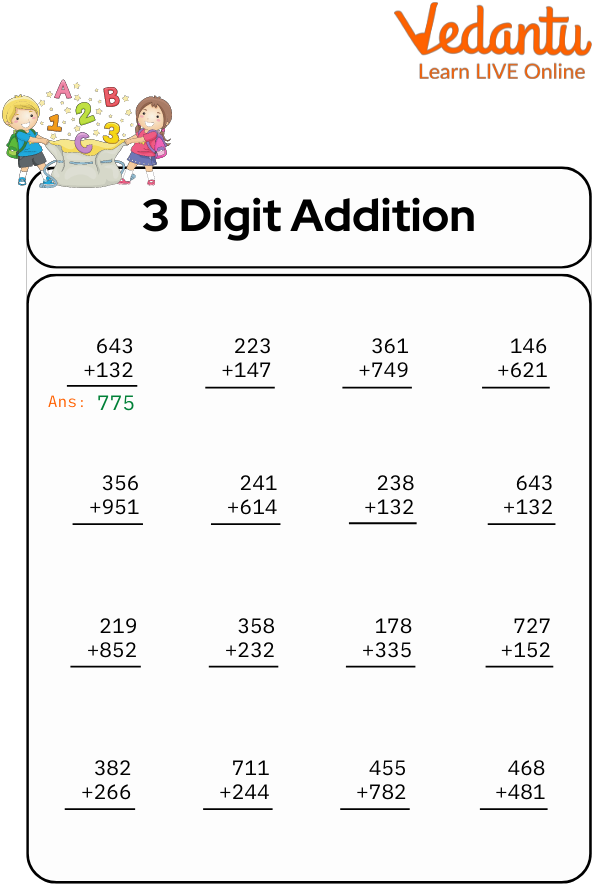




Step-by-Step Methods for Adding and Subtracting 3-Digit Numbers
What do you understand by the term, "putting things together"? The term "putting things together'' is used for addition. Removing things from a group of several things is equivalent to subtraction. In this article, we will be learning about 3-digit addition and subtraction by making use of several creative images for a better understanding of the topic. Some 3-digit addition worksheets, along with addition practice problems are assigned for getting a hold of the concepts. Let us now begin with the learning.
3-Digit Addition and Subtraction
In performing 3-digit addition or subtraction, one needs to place the given numbers into columns according to their respective place values, like ones, tens, hundreds, thousands, and so on.
While performing addition, one should keep in mind that the numbers being added are known as addends, and the result of their addition is known as the sum.
While performing subtraction, one should keep in mind that the numbers being subtracted are known as subtrahend, the number from which the subtrahend is subtracted is known as minuend, and the result of their subtraction is known as the difference.
Steps to Solve 3-Digit Addition
If one wishes to add three-digit numbers, then the addition always adds the digits according to the place value. Some steps to carry out the operation are given:
Arrange the given numbers in columns based on their place value
Beginning with ones location and progressing to tens and hundreds place
If the problem involves regrouping, i.e. the sum is greater than 9, then put the tens digit of the sum onto the successive digit
Now, add the digits on which the carry is put, and finally, add the carry also to get the required sum at that place value
Repeat the same process till the addition of all the digits does not take place.
For Example: If we wish to add 526 and 214. We start this addition by placing the numbers in column form based on their place value. Then add 6 and 4 to obtain 10, which is greater than 9, so we will use regrouping. It will add 1 to the sum of tens place digits, i.e. 2+1+1, which gives the result as 4. Now take the sum of 5 and 2, which will give 7. So, the addition of 526 and 214 is 740.

Addition of 3-digit Numbers
Steps to Solve 3-Digit Subtraction
The following are the steps for solving the subtraction of 3-digit numbers:
Arrange the given numbers in columns based on their place value
Starting with the ones place and then moving to tens, and hundreds place
If the problem involves borrowing, i.e. the ones place of minuend is less than the ones place of subtrahend, then borrow the carry from the successive digit, which after providing borrowing reduces by 1
Repeat the same process, till the complete subtraction of the digits does not take place.
For example: If we wish to subtract 203 and 110. We will start the subtraction from the right by placing the numbers according to their place values, i.e. 3-0 to obtain 3. As 0 is less than 1, we will borrow a carry of 1 from 2 and then subtract 1 from 10 to get 9. Now 1 is left at the place of 2, taking its difference with 1 results in 0. So, the difference between 203 and 110 is 93.
Solved Examples
Q 1. Add 436 + 486.
Ans: Some steps to carry out the addition are given:
Arrange the given numbers in columns based on their place value
Begin the addition from the ones place, i.e. 6 and 6
As the problem involves regrouping i.e. the sum of 6 and 6 is 12, which is greater than 9, thus put the tens digit of the sum, i.e. 1 onto the successive tens digit
Now, add the tens place digits, i.e. 3 and 8, and also add one carry to obtain the sum
Put the carry of tens place, i.e. 1, onto the digits at hundreds place and repeat the addition process, i.e. 4 and 4 with one carry.
Thus, the result of the addition of the three-digit problem is 922.

Addition of 3-digit Numbers
Ques 2. Subtract 326 and 103.
Ans: Some steps to carry out the operation are given:
Arrange the given numbers in columns based on their place value
Starting the subtraction with the ones place, i.e. 6 and 3
As the problem does not require any borrowing, so moving to the tens place and proceeding to calculate the difference between 2 and 0, which is 2
Then moving to the hundreds place and subtracting 3 and 1, we get 2
Thus, the result of the three-digit subtraction problem is 223.
Subtraction and Addition Practice Problems
Q 1. By using addition with regrouping, add 182 + 50.
Ans: 232
Q 2. Add 600 + 450.
Ans: 1050
Q 3. Subtract 512 - 100.
Ans: 412
Q 4. State true or false: 650 + 420 = 1070.
Ans: True
3-Digit Addition Worksheets
3-digit addition with a carryover worksheet is given, which needs to be solved by the students themselves, without any help.

Worksheet
Summary
To wrap up here with the topic of 3-digit addition and subtraction. Mathematics deals with the grouping of numbers according to their place value to perform a particular arithmetic operation. This article has discussed in detail the steps performed to add and subtract a three-digit number. Some 3-digit addition with carryover worksheets are also assigned to the students for practice and to get hold of the concepts. I Hope you find it useful to read the article. Feel free to put your doubts in the comments.
FAQs on 3-Digit Addition and Subtraction Made Simple
1. What is meant by addition of 3-digit numbers?
Addition of 3-digit numbers means finding the total by combining two or more numbers that each have three digits. You line up the numbers by their place values and add, carrying over if the sum in any place is more than 9.
2. How do you subtract 3-digit numbers with borrowing?
To subtract 3-digit numbers using borrowing, start from the units column. If you cannot subtract the lower digit from the upper, borrow 1 from the next column to make subtraction possible, and continue until all columns are complete.
3. What are common mistakes when adding 3-digit numbers?
Common mistakes in the addition of 3-digit numbers include:
- Not aligning numbers by place value
- Forgetting to carry over numbers
- Incorrectly adding each column Always write carefully and check each step to avoid these errors.
4. Why is place value important in 3-digit subtraction?
Place value is crucial in 3-digit subtraction because it ensures you subtract the correct digits from each place (hundreds, tens, units). Without matching the right place values, the answer will be incorrect. Always line up the digits properly first.
5. What is the column method for 3-digit addition?
The column method for 3-digit addition means writing numbers vertically, aligning by hundreds, tens, and units. Add from right to left. If any column’s total is larger than 9, carry over to the next left column and continue.
6. Can you give an example of subtracting 3-digit numbers?
Sure! For subtraction: $456 - 187$. Start from the right:
- 6-7: Borrow, becomes 16-7=9.
- 4-8: After borrowing, becomes 13-8=5.
- 3-1=2.
7. How do you know if your answer to a 3-digit addition is correct?
To check a 3-digit addition answer, add the numbers in reverse order. Also, try subtracting one number from your total; if you get the other number, your answer is correct. This process is called verifying your sum.
8. What are some tips for teaching addition and subtraction of 3-digit numbers?
When teaching 3-digit number addition and subtraction:
- Use clear place value columns
- Give lots of practice with and without carrying or borrowing
- Show real-life examples
- Encourage checking answers by reversing the operation.
9. How do you add three 3-digit numbers together?
To add three 3-digit numbers, write each number in a column, aligning by hundreds, tens, and units. Add each column from right to left, carrying over as needed, until you reach the final sum.
10. What is regrouping in addition and subtraction?
Regrouping is the process of carrying over in addition or borrowing in subtraction when the digits in one column add up to more than 9 or when the top digit is smaller than the one below in subtraction. It helps solve 3-digit problems accurately.
11. What math skills are built by adding and subtracting 3-digit numbers?
Learning to add and subtract 3-digit numbers builds:
- Place value understanding
- Logical thinking
- Accuracy with carrying and borrowing
- Problem-solving skills





















